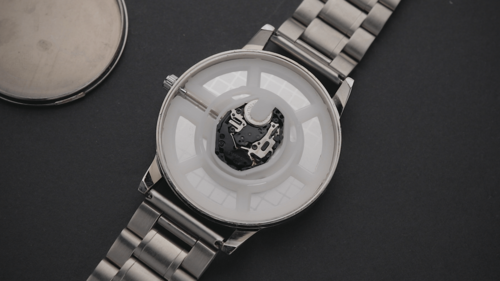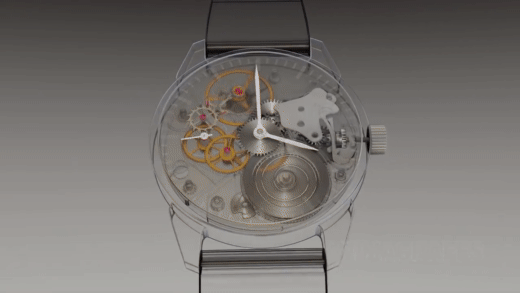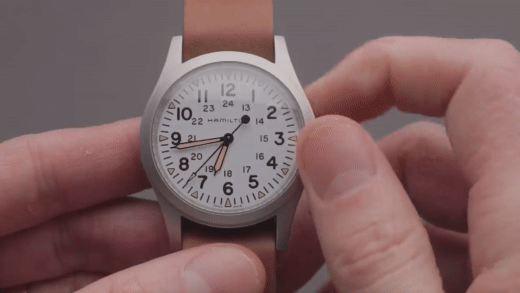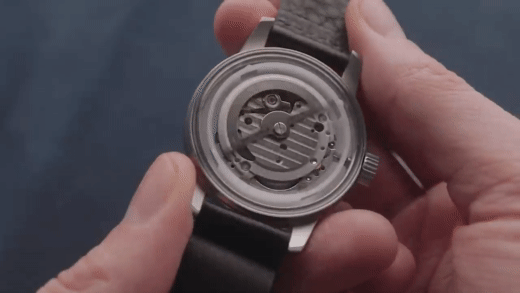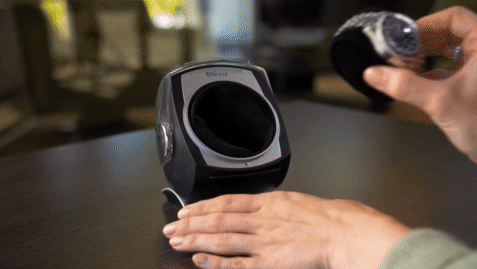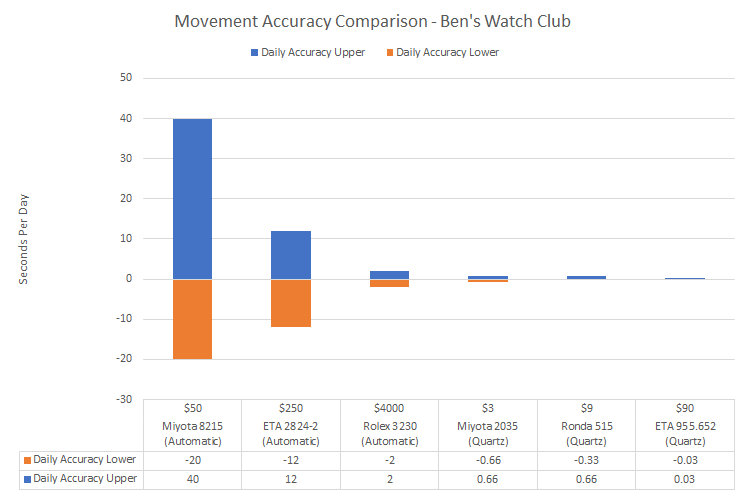What Are Automatic Watches And How Do They Work? - Automatic Watches Explained for Beginners
Many of the watches reviewed on Ben's Watch Club are 'automatic' watches. But what exactly are automatic watches? Perhaps you've seen the term floating around but aren't 100% sure what it means.
A skeletonized automatic watch
Well, in this article, I'll give you the full lowdown on automatic watches: what they are, how they work, the parts they're made of, and whether they're 'better' than other wristwatch types.
Most timepieces you've likely encountered are 'quartz' watches. These are the lower-cost battery-powered watches you frequently see in jewelers, fashion outlets, grocery stores, and many online retailers. These essentially use an electrical circuit (involving a tiny piece of vibrating quartz) to tell the time. Watches with a quartz movement are accurate, require little maintenance, and the second hand usually ticks once per second.
A quartz movement in a Spaghetti Scameti watch
A typical quartz tick
These are pretty different from automatic watches in several ways.
How Do Automatic Watches Work?
Mechanical watches, including automatics, do not use electrical circuits and consequently do not require batteries. Instead, these watches use a complex series of gears and springs to tell the time, like old-school clockwork mechanisms. Rather than extracting power from a battery, these movements require energy from the user (you) to function correctly. A user does this by 'winding' a long coiled spring known as the 'mainspring'' Once fully wound, the spring slowly releases energy over time, powering the rest of the components.
The inner workings of a mechanical movement. Animation credit: Animagraffs
These clockwork marvels are easy to spot, as their second hands usually 'sweep' smoothly rather than ticking once per second.
Automatic hand sweeping action on the Maen Greenwich GMT
There are two main methods of winding. These differing approaches separate 'automatic' watches from regular 'mechanical' ones:
Mechanical Movements Explained
Traditional 'mechanical' watches with 'hand wound' movements require the user to manually rotate the crown (the circular thing on the side of the watch) multiple times to get the action started. It's similar to winding up clockwork toy cars; spinning the crown directly winds the mainspring. You must repeat this process every day or two to keep the watch powered, or it will run out of power and stop.
Hamilton H-50 mechanical movement (rear removed)
Manually winding the Hamilton Khaki Mechanical Field
Automatic Movements Explained
That's where automatic watches come in. Automatic movements are a development of mechanical movements, housing a large additional rotor, which rotates in response to your arm's natural movements and vibrations throughout the day. The rotor's spinning 'automatically' winds the watch's mainspring for you, meaning the watch will continue telling the time so long as it's worn daily.
An automatic watch rotor in action
How To Wind an Automatic Watch
Entry-level automatics, like the venerable Seiko 7S26, require the user to effectively 'shake' the watch to start the movement, as they lack the hand-wind function of traditional mechanicals. However, more premium automatic movements allow you to utilize both winding methods.
If automatic watches are left without being worn for longer than their stated 'power reserve,' they will stop telling the time.
What Are Watch Winders? (Why Do People Use Them For Automatic Watches?)
Some people use electronic watch winders to keep their automatic watch running (and fully wound) when it's not being worn. These devices physically rotate the watch, usually inside a small box, to simulate the natural motion of a human arm. This process keeps the rotor spinning, allowing the movement to remain sufficiently powered. The user can remove their automatic watch from the winder ad hoc and wear it immediately without requiring manual winding.
A single and triple watch winder. Image credit: Bob’s Watches
Are Automatic Watches Better Than Quartz?
Automatic watches tend to be more expensive than quartz; does that mean they're better? In terms of raw time-telling functionality, like traditional mechanical watches, automatics are actually inferior to lower-cost quartz options. On average, they are less accurate than even the cheapest battery-powered watches, and due to the complexity of the components, you'll be spending more for the privilege.
The lowest-cost quartz watches are more accurate than luxury automatics
Nevertheless, many argue that automatic watches are of higher quality than quartz watches, given the manufacturing precision and weighty feel the movements provide. If appropriately maintained, automatics can also outlast most quartz movements, which often become disposable if they break down.
Additionally, smartwatches, smartphones, and computers have all supplanted quartz watches in terms of pure accuracy [1]. Consequently, many believe watches should now be seen as stylish accessories or mini works of art for wearers to express themselves with, as opposed to purely practical devices. In that context, automatic watches are undeniably classier, with their elaborate movements and the entrancing sweeping second hands.
Are Automatic Watches Worth It?
Quartz watches are probably worth purchasing if you're after a purely practical watch for usage in places where a phone may be unusable (underwater, in remote wilderness, etc.).
However, automatic watches are undoubtedly worth considering if you're looking for a timepiece for formal events or a fashionable accessory. I can tell you from personal experience that nothing matches the quality on-wrist feeling you get with a mechanical or automatic watch; it's hard to return to quartz once you've tried one.
They also don't use batteries, so they are more eco-friendly but may require maintenance to remain in optimal condition.
Compared to hand-wound movements, automatics are easier to use. Nevertheless, due to the additional rotor, automatic movements tend to be chunkier, meaning super slim automatic watches are a rare and often expensive sight.
Automatic Bulova (black band) and Hamilton Khaki Mechanical (tan band) thicknesses compared
History Of Automatic Watches
Automatic watches date back to the late 1770s. Known then as 'self-winding' watches, they were first invented by Abraham-Louis Perrelet, though his implementation was said to use a weighted pivot at the side of the movement[2]. In 1778, rival watchmaker Hubert Sarton introduced a version utilizing a more familiar central rotor arrangement[3].
The 1777 Perrelet self-winding pocket watch. Image credit: Perrelet
Of course, these early experimental movements were designed with pocket watches in mind; it took another century and a half for automatics to make their way into the wristwatches we know today. World War I saw many rapid technological advances, including the refinement of wristwatch manufacturing processes.
First Automatic Watch
British watchmaker John Harwood was the first to patent an automatic wristwatch in 1923. The 'Harwood Self-Winding Watch' curiously had no crown by design, which helped seal it from the elements completely. To set the hands, you had to rotate the watch's bezel[4]. The power reserve of this first automatic watch was said to be 6-12 hours, and it used a bumper mechanism to prevent overwinding.
The Harwood Self-Winding Watch. Image Credit: Deutsches Uhrenmuseum
Harwood’s Automatic Movement Patent. Image Credit: Harwood Watches
Rolex’s Apology to Harwood. Image Credit: Harwood Watches
Rolex arguably released the first practical automatic watches in the 1930s with the continued development of their 'Perpetual' rotor series[5], which boasted a greater-than-24-hour power reserve. Rolex publicly apologized to Harwood in 1956 after falsely that they were the original inventors of the self-winding rotor mechanism in a newspaper advertisement earlier that year[6]; naughty, naughty!
What are Skeleton Watches?
Skeleton watches are mechanical watches styled to make the movement wholly or partly visible through the case's front, side, or rear. These can be hand-wound or automatic movements, depending on the model. Skeleton watches are functionally identical to standard mechanical watches, though their movements are often more decorated to suit the skeletonized design.
Stuhrling Skeleton Watch
Stuhrling Skeletonized Rear
Parts of An Automatic Watch
What makes an automatic watch tick? Here are all of the main components and parts that make up an automatic movement:
Assemblies:
Crown Assembly
Mainspring
Gear Train
Escapement Mechanism
Motion Work
Main Parts:
Balance wheel
Complications
Escape wheel
Hairspring
Jewel bearings
Oscillating rotor (automatic watches only)
Setting jumper & lever
Spring barrel
Support plates
Winding stem
Winding pinion
Yoke & sliding pinion
For more information on these parts' roles, check out our in-depth article on the parts of a mechanical watch.
References:
[1] Williams, Rhiannon (Dec 2015). "Why the Apple Watch will be the most accurate way to ring in the New Year". The Telegraph.
[2] Watkins, Richard. "The Origins of Self-Winding Watches, 1773 to 1779". Retrieved 06 October 2022. page 43.
[3] Minutes. T97 (1778) / Royal Academy of Sciences, 1667-1793. Retrieved 06 October 2022
[4] Harwood Watches. Retrieved on 06 October 2022
[5] Rolex Watches. Retrieved on 06 October 2022
[6] Harwood Watches. Retrieved on 06 October 2022



